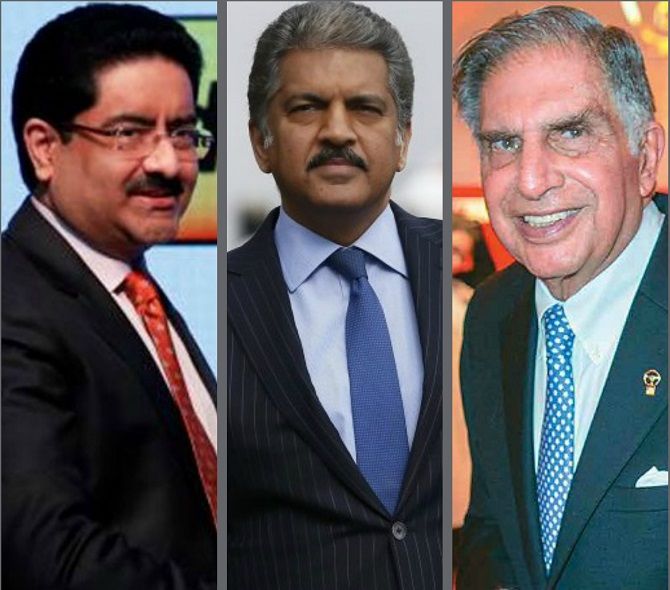One thing has remained constant through the Indian economy in the last seven decades: the dominance of family-owned businesses. Krishna Kant reports.

Photographs: (From left) Danish Siddiqui/Reuters; Stefan Wermuth/Reuters; and Christian Marquardt/Getty Images.
India has gone through many cycles of economic growth since its independence from British rule in 1947. But one thing has remained constant through the economy in the last seven decades: the dominance of family-owned businesses in India. Most of the country's largest companies across sectors continue to be family owned despite the rise of government-owned and institution-owned enterprises in the last 70 years.
Starting as an open market economy, India became a planned economy by the mid-1950s where private enterprise was forced to play second fiddle to the newly established public sector. Things came full circle in 1991 when economic planning was dropped in favour of the market mechanism and the private sector was once again free to grow as it wished.
This cycle has created a series of winners and losers with a steady rise of new companies and decline of older, inefficient ones.
For example, only three business groups have been able to maintain their presence in the league table over the years: Tata, Birla (now AV Birla) and Mahindra. These three business groups were ranked among the country's top 20 business houses in 1951, and they are still among country's biggest business groups in terms of combined assets of their listed group companies.
With the exception of the House of Bajaj, ranked 18th in 2017, no other business group in the top 20 list existed at the time of Independence.
Today's large business groups such as Mukesh Ambani, Bharti, Vedanta, Adani, JSW, OP Jindal, Wipro and Sun Pharma are products of the economic changes brought about in the 1980s and 1990s.
This, say economists, shows the dynamism of the Indian economy and its entrepreneurial class.
"India's private sector certainly does appear to have become more dynamic in relation to the situation that obtained in the immediate post-Independence period," says Raman Mahadevan, economist and business historian based in Chennai.
He says that one of the distinctive features of the contemporary history of the Indian corporate sector is the persistence of family control over firms and companies.
This is certainly borne out by the data.
Family-owned enterprises control the majority of corporate assets and generate the bulk of revenue in the organised sector despite the massive growth of the public sector during the post-Independence period. For example, family-owned business groups accounted for 84 per cent of all assets of the top 20 business groups in 2016-17 and 79 per cent of their revenue.
In all, family-owned enterprises accounted for 60 per cent and 55 per cent of the combined assets and revenues, respectively, of all listed companies in 2016-17. In comparison, the share of public sector companies in assets was 30 per cent 2016-17, while institution-owned independent companies controlled around 8 per cent of corporate India's assets.
The analysis is based on the common sample of 820 companies that are part of the BSE 500, BSE Mid-Cap and BSE Small Cap indices. The business houses have been ranked according to the combined assets of their listed companies.
The numbers for the Tata and Godrej groups include the 2015-16 standalone figures for group unlisted holding companies Tata Sons and Godrej & Boyce, respectively.
The numbers have been adjusted for listed subsidiaries of listed firms.
For banks and financial services firms, net worth has been considered rather than assets.
Economists attribute the persistence of family enterprises to the ability of the business community and entrepreneurs to adapt to the changing external environment and government policies.
"The industrial licensing system was utilised by established business groups to effectively pre-empt capacity in many industries and thus prevent entry of new capital," says Mahadevan.
Beginning in 1970, there was rise of a class of first-generation entrepreneurs who grew by becoming vendors to large private and public sector enterprises in engineering. Many of these entrepreneurs now own some the country's biggest companies in sectors such as automobiles, automobile ancillaries, consumer durables, metals, mobile telephony, pharmaceuticals, and chemicals.
Older business groups that failed to enter these sunrise sectors and remain wedded to older industries such as textiles or agro-based consumer products declined in importance over the years.
The role of portfolio is clearly visible in the continued dominance of the Tata and Birla groups.
The Tatas, for example, were one of the first to exit textiles and invest in emerging sectors such as automobiles and informational technology. The Birlas, on the other hand, made big bets on cement, non-ferrous metals and telecom. These industries now dominate their portfolios.
Family-owned businesses are once again at the cross-roads with many struggling with poor domestic and global growth coupled with high indebtedness in many of their key companies.
At the same time, they face challenges from first-generation businesses or multinationals, which have none of the historical baggage that business groups carry.
Experts, however, do not see any immediate danger to the dominance of family firms in India, given their deep roots in the economy.










